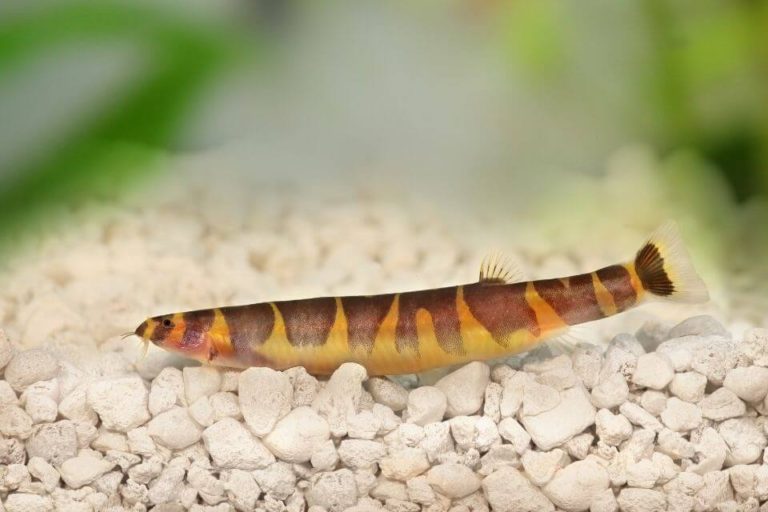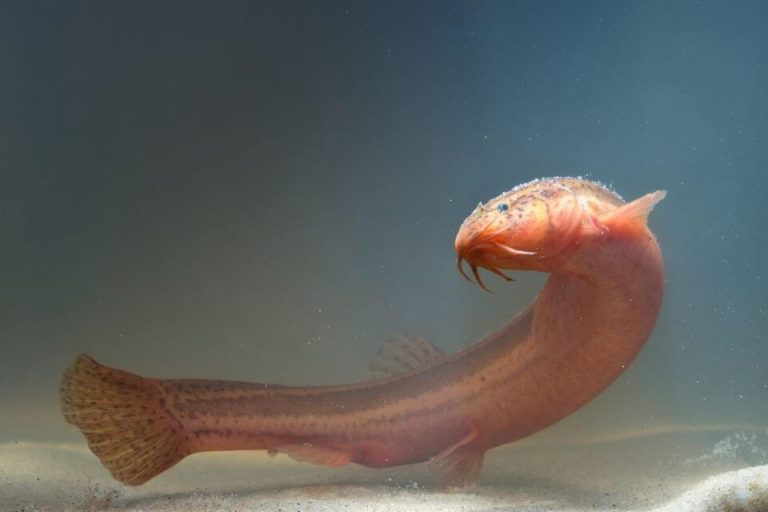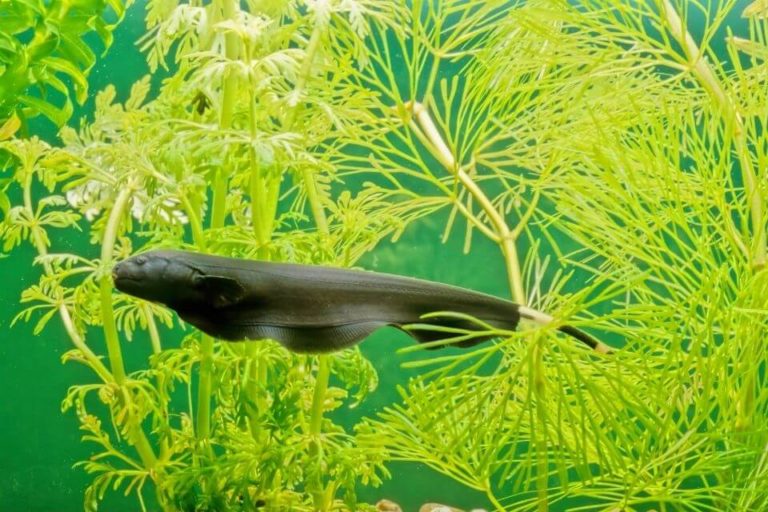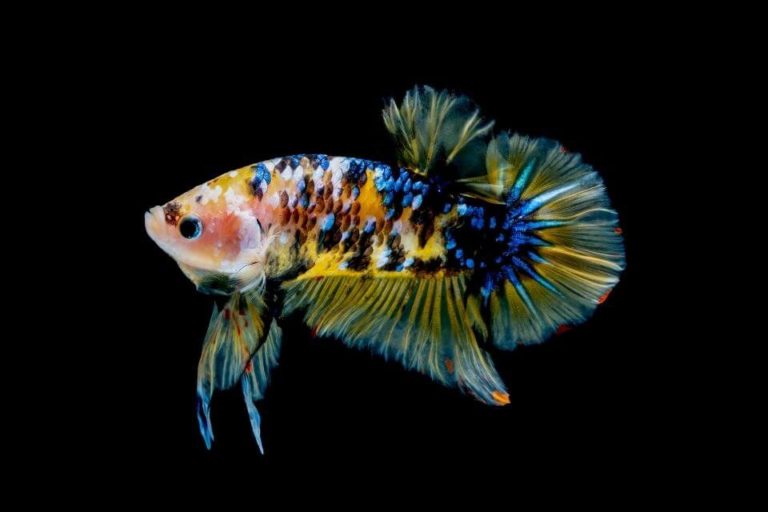Amano Shrimp Care Guide: Tank Mates, Tank Size and Food
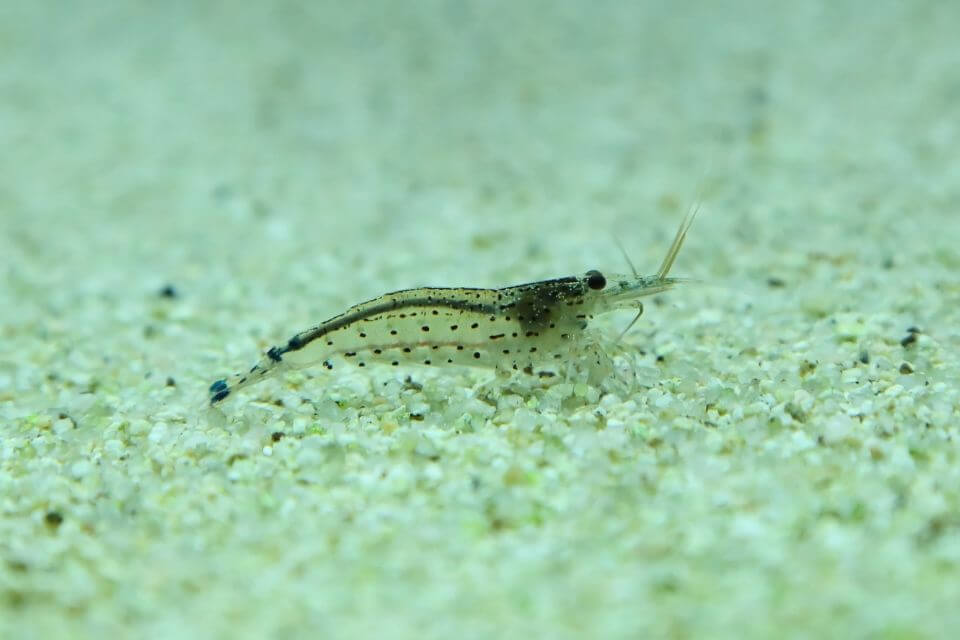
Amano Shrimps are among the best, most peaceful, and most beautiful inverts for freshwater aquariums. In their natural habitat, Amano Shrimp live in large troupes in freshwater rivers or streams.
Amano Shrimp are native to Taiwan, Japan, Fiji, China, parts of Korea, and Madagascar. They are named after the aquarist Takashi Amano who discovered Amano Shrimp’s ability to control algae growth in aquariums in the 1980s.
Today Amano Shrimp are kept for hobbies and to elevate the aesthetics of the aquariums with other peaceful fish species.
In this Amano Shrimp care guide, we will explore in detail this species to help you take care of your aquarium pet.
Species Overview
Its scientific name is Caridina multidentata, and they belong to the Atyidae family of freshwater shrimp. Amano Shrimp origin is Southeast Asia, and they are considered a natural cleaner because they will leave no algae in your fish tank.
Amano Shrimps’ calm temperament makes them highly compatible with other members in the aquariums because they are always busy searching for algae.
The alternative names include Yamoto Shrimp, Japonica Amano, Algae Shrimp, and Japanese Swamp Shrimp.
Amano Shrimp Size
An adult Amano Shrimp size can grow up to 2 inches in length. However, in a pet store, you will likely see Amano Shrimp size of about or less than 1 inch. This makes Japonica Amano Shrimp among the largest dwarf shrimp species kept for aesthetics.
The male Amano Shrimp size is relatively small compared to their female counterparts, about 1.4 inches, but female goes up to 2 inches in length.
Amano Shrimp Lifespan
When in captivity, the Amano Shrimp lifespan of a healthy one is between 2 to 3 years. However, there are reports that Amano Shrimp die at a young age or immediately after putting them in the aquarium.
The primary cause is poor handling during transportation or from the change in water parameters such as pH or temperature, which are inconsistent with their natural environment.
If all the conditions, water temperature, pH, right and plenty of foods and no predators, Amano Shrimp lifespan can be long up to 5 years.
Take note, when an Algae Shrimp dies, its color changes from gray or transparent body to bright orange, and you might see other shrimp eating it.
It is always a good idea that when Amano Shrimp dies, remove it to avoid an Ammonia spike in the fish tank, which is lethal to other aquarium inhabitants.
Appearance and Coloration
They are mainly translucent, light or reddish-brown or tan in color. Some may have a tan or brown stripe running the length of their translucent body with reddish-brown or greyish-blue dashes or dots on the sides of their body.
A narrow lighter strip runs the length of Amano Shrimp topside of their bodies. One unique thing about Algae Shrimp is that they can change their body color based on their diet.
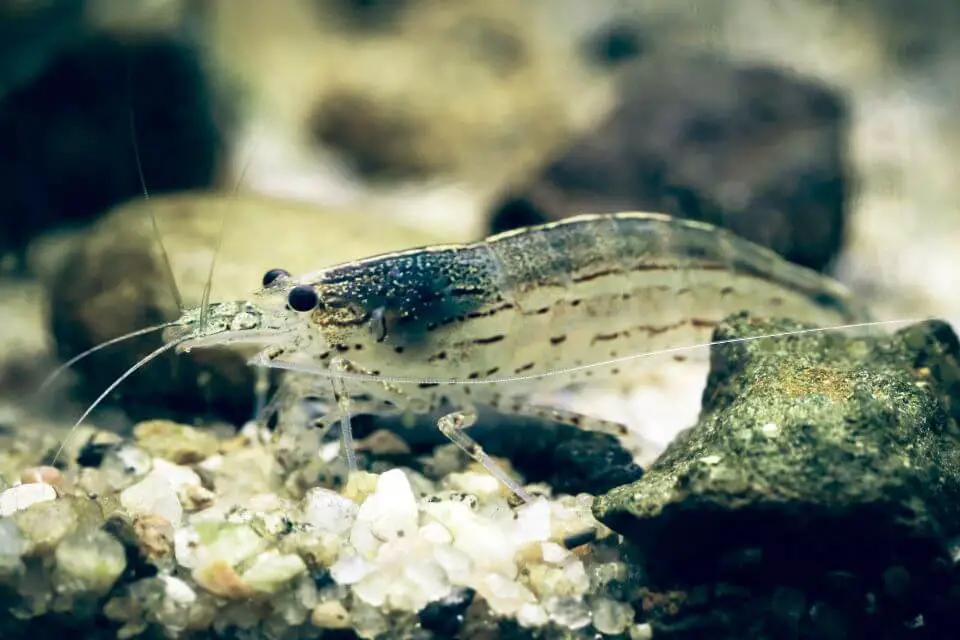
Scientists have established that if you feed Amano Shrimp with algae, their body develops a greenish texture, but their body will add a reddish tint if you give them fish food.
Generally, Amano Shrimps have two large black eyes, a relatively long set of antennae, long elegant legs, and a broad and transparent tail.
Amano Shrimps can effectively camouflage into the natural environment and even in the fish tank to evade their predators.
Behavior And Temperament
Amano Shrimps are known to be peaceful creatures and highly adaptable in nature. They are, however, relentless on food, and they spend most of their time moving from one place to another scavenging for dead matters.
If you put some food into the tank, Algae Shrimps will race and swarm over it. Perhaps that is why many aquarists call them greedy, a feature that makes them excellent algae cleaner in aquariums.
The ability of Amano Shrimps to camouflage can make it difficult for you to spot them in the fish tank. In fact, if they don’t want to be seen, they will not be seen.
Amano Shrimp Care
When all conditions for Amano Shrimps are fulfilled, most importantly mirroring their natural habitats such as crystal-clear water and enough food, Amano Shrimps will reward you by cleaning the fish tank while augmenting the aesthetics of your aquarium.
General care includes maintaining the right water temperature, acidity levels, water hardness, and lighting requirements.
– Amano Shrimp Tank Size:
The ideal tank size is 5 gallons for Amano Shrimps. The idea is that for 1 Amano Shrimp, you get 3 gallons; hence 5 gallons should be the minimum tank size to house 2 to 3 shrimps.
It is imperative to have in mind when determining the tank size that Algae Shrimps are excellent jumpers, specifically when excited and natural escape artists. Covering your tank is an additional precaution.
You can use a glass tank cover or a cover lid. Avoid mesh nets because they are too wide for Amano Shrimps. Although 1 Amano Shrimp for 3 gallons is a rule of thumb, you can often get away with less than recommended 5 gallons.
Because they are incredibly active, mainly at the bottom of the tank, scavenging and eating waste and algae from your aquarium. It would be better to have 10 gallons tank when it is kept with other peaceful tank mates.
– Amano Shrimp Tank Setup:
Pick natural items such as plants and driftwood when decorating the tank. Though Amano Shrimps quickly adapt to any setting, the natural environment rhymes with their color.
The dark backdrop of driftwood makes Algae Shrimps stand out. Cholla wood is excellent driftwood to put in the aquarium because it brings the feel of natural habitat to Amano Shrimps while providing them with food as it decays.
You can also fill your tank with a substrate such as Fluval stratum and small pebbles to substitute natural rocks in Amano Shrimps’ natural environment.
Moss is another crucial accessory to consider when setting up Algae Shrimp’s tank. Moss act as a good hiding place for Amano Shrimps to feel safe and calm.
The female Amano Shrimps tend to become brighter than usual when they are relaxed and feel safe.
Make sure you use a proper tank filter to provide your Amano Shrimps with quality water. We recommend picking Algae Shrimp tank filters designed for your aquarium size.
– Water Parameters and Testing:
Amano Shrimp thrives well in a water hardness of 7-8 Dgh, 0-10 Carbon Hardness (KH), and a pH range of 6.5-7.5. Water hardness is a vital parameter to Amano Shrimps.
It is important to note that the general hardness (GH) reflects the overall concentration of salts such as magnesium, calcium, iron, and many more. Understanding their source and how to test them is essential in controlling water hardness in your aquarium.
Unless you live in a freezing climate, you don’t need a heater. Amano Shrimps will do well in a 64º F winter as they would in 82º F summer.
– Suitable Aquarium Plants:
The perfect environment for Amano Shrimps is to include plants and greenery that act as a food source and provide them with a hiding or a playing place. Here are some of the plants you can have in your aquarium:
- Moss plants such as Java Moss
- Pearl weed
- Dwarf lily
- Hornwort
- Anacharis plant
- Dwarf Hairgrass
- Anubias
Note: Some plant distributors spray plants with pesticides that can harm your Amano shrimp. Therefore, it is essential to buy from reputable plant distributors who comply with USDA regulations regarding agricultural pests. Even small traces of pesticides in the shrimp plant can kill your Amano shrimp.
Amano Shrimp Diseases and Prevention
Amano shrimp are known to suffer from a variety of infectious and non-infectious diseases. The diseases could be a result of viruses, bacteria, or fungi.
Generally, the ideal way to eliminate Algae Shrimps diseases is by implementing good management or prevention strategies. Here are some common Amano Shrimps diseases and their prevention:
Yellow Head Disease (YHD):
The infected shrimp show signs of lack of appetite, pale body, and slow swimming. There is no available treatment for YHD, but prevention and control are done by disinfecting the contaminated aquarium.
Use about 3% Hydrogen peroxide solution to treat the tank. Maintaining ideal water quality and feeding routine remains an excellent way to prevent YHD.
Luminous Vibriosis:
This is a high mortality rate bacteria disease that makes infected shrimp swim near the surface and edges of the tank. Severely infected shrimps will show vertical swimming behaviors.
Proper water management is recommended as the best preventive practice for this disease.
White Spot Syndrome Virus (WSSV):
The viral disease causes a rapid reduction in food consumption. Affected shrimps display loose cuticles with white spots.
The prevention includes avoiding rapid changes in water conditions, fresh feeds, and stress, and minimizing water changes to prevent the virus carriers from entering your aquarium.
Amano Shrimp Diet and Feeding
Amano Shrimps’ favorite diet is algae. The Amano Shrimps are omnivores meaning they will eat pretty much anything to diversify their diet. They will eat algae, even the types most fish will not eat, such as bearded algae.
Amano Shrimps’ preferred algae include but are not limited to:
- String algae
- Brush algae
- Hair algae
Other foods you can feed Amano Shrimps to supplement their diet include:
- Fish flakes
- Fish pallets
- Bloodworms
- Vegetables such as spinach and zucchini
Since Amano Shrimps are larger than dwarf shrimps, you may need to feed them a bit more, 2-3 times a week.
Avoid overfeeding them because the leftover foods break down in the aquarium, releasing ammonia and nitrates, which are toxic to Amano Shrimps.
Note: Avoid feeding Amano Shrimps with food products grown with fertilizers containing copper or copper sulfate. Make sure you read the ingredient label before buying to ensure they are copper-free.
Amano Shrimp Male Vs Female Difference
You can tell the sex of Algae shrimp by their size. Female Amano Shrimps are more prominent than males.
Another distinction is that male Amano Shrimp have nicely spaced dots running the length on the sides while female Amano Shrimp have relatively long broken stripes.
Another physical difference is that the female Amano Shrimp have a rounder abdomen and an identical saddle beneath its belly.
Amano Shrimp Breeding
Amano Shrimp becomes mature and ready for breeding in about 4 to 5 months. If all conditions are suitable a female Amano Shrimps will look for a safe place in the aquarium and release pheromones.
The process is quite basic, and no intervention is needed from your end. However, for successful breeding, ensure there are enough male Amano Shrimps for the female Amano Shrimps.
It is recommended that you keep an even ratio of males to females. The female Amano Shrimps carry their eggs for 3 weeks under their abdomen. Move the eggs to a separate tank with salt water to prevent fertilized eggs from dying.
You can also move fertilized females to a different tank. Once the females lay the eggs, they can be transferred back to their original aquarium.
After the incubation period, you can tell this phase when you start seeing larvae floating freely in the water. You can start feeding the young Amano shrimp. After 20 days, you can transfer them to the main tank with the other Amano Shrimps.
Note: Breeding Amano Shrimps is not easy, but it is always good to try it.
Amano Shrimp Tank Mates
The small size of Algae shrimp can make many tank mates target them for food. This makes it important to be extra careful when choosing their tank mates. Here is a list of Amano Shrimps safe tank mates you can choose from:
- Ember Tetra
- Neon Tetra
- Otocinclus Catfish
- Guppies
- Bolivian Ram
- German Blue Ram
- Other shrimp such as Cherry Shrimp
Here are some tank mates you need to avoid:
Origin And Distribution
The true origin of Amano Shrimps is reported to be swamps of Japan, but they are also common in the Southeast Asia region. The aquarist Takashi Amano is the origin of Amano Shrimps, becoming popular among modern aquarists.
He discovered and later spread the word of Amano Shrimps’ ability to eat algae, which helps keep the fish tank clean and safe for other habitats.
Amano shrimp, named after Takashi Amano, are unique creatures embraced for their beauty, calmness, and their high adaptability, meaning they can migrate from fresh to salt water during their life.
FAQs
Are Amano Shrimp Aggressive?
Amano Shrimps are pretty friendly and live peacefully with other tank mates. They are also highly compatible with other shrimp species, such as Cherry shrimp.
However, Amano Shrimps are aggressive when grabbing food.
Are Amano Shrimp Hardy?
Amano shrimp are among the easiest shrimp species to care for. Their ability to withstand a broad range of temperatures meaning they don’t demand specific water parameters makes them the top choice for many aquarists.
Amano Shrimps are suitable for beginners because they don’t require too much attention.
Are Amano Shrimp Nocturnal?
Amano shrimp are neither nocturnal nor diurnal. They can be active during the day and even at night. Even though some people report their Amano Shrimps to hiding during the day.
That indicates that these species hide during the day in the plants to eat algae and protect themselves from predators. They often come out at night because they feel safe, especially if they live with tank mates such as fish.
So, when fish sleeps, Amano Shrimps become quite active because they are alone. Excessive light could also be why your Amano Shrimps prefer emerging at night.
How Many Amano Shrimp Per Gallon to Keep?
As mentioned earlier, 2 to 3 gallons per shrimp is the general rule. Therefore, if you have a tank size of 15 gallons, you can put 5-6 Amano Shrimps.
Can Amano Shrimp Live with Cherry Shrimp?
Yes, Amano Shrimp can peacefully live with Cherry Shrimps. The two species have similar water requirements, including water hardness and pH. I think many hobbyists’ concern is crossbreeding, which is rare.
What Is the Difference Between Amano Shrimp Vs Ghost Shrimp?
The main difference between Amano Shrimp and Ghost Shrimps is that Amano Shrimp are bottom feeders. They spend most of their time looking for algae at the bottom of the tank.
Ghost Shrimps, on the other hand, are always near the top of the tank.
Another difference is that Amano Shrimps are easy to spot because of their transparent grey bodies; unlike Ghost Shrimps, true to their name, they are difficult to see because of their transparent body.
How Much Does Amano Shrimp Cost?
The cost of Amano Shrimps may vary depending on your source. You may buy in some places at $ 2.50 each, $3 per shrimp, or 20 packs for about $60. Based on the current market, the average cost per Amano Shrimp is $5.
Final Thoughts
Amano Shrimps are calm, peaceful, and highly social inverts you can add to your aquarium to augment the beauty of your tank. Having Amano Shrimps will keep your aquarium clean from algae, given their love for them.
You must be careful when choosing Amano Shrimps tank mates because some fish species, such as clown loaches and even some snails, can be aggressive toward the peaceful Amano Shrimps.
Amano shrimp are among the most popular aquarium hobby; therefore, they are readily available in the market. However, we caution you to buy only from trusted and reputable sellers because there are many Amano Shrimps imitations.
The same caution should be applied when purchasing foods to supplement the diet for your Amano Shrimps.
We hope this article presents you with the relevant knowledge to get you started and help you take good care of your Amano Shrimps.
The goal is to give you basic information about the Amano Shrimp species so you can gain insights to guide you further. We recommend contacting experienced professionals if you need in-depth information about Amano Shrimps.



